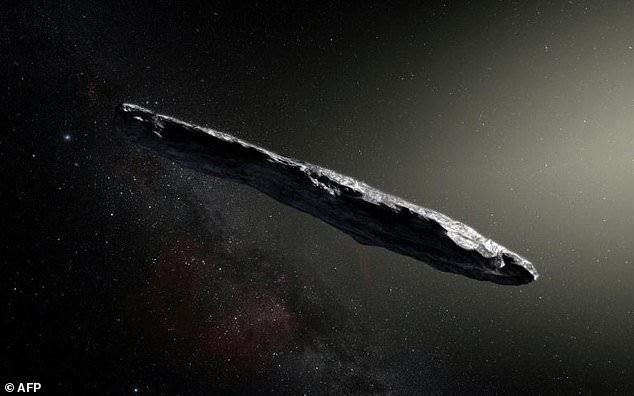Researchers have used a high powered radio telescope to study the insterstellar comet 'Oumuamua in a bid to find out if it is an alien craft.
Scientists at the SETI Institute attempted to answer the controversial claim by Harvard researchers using the Allen Telescope Array (ATA) to observe 'Oumuamua when it was about 170 million miles away, or slightly less than the diameter of Earth's orbit.
If artificial radio transmissions were found, researchers say it would have been 'strong evidence' the mysterious object is not simply a rock tossed into space by a random gravitational slingshot interaction that occurred in its home star system.
'We were looking for a signal that would prove that this object incorporates some technology – that it was of artificial origin,' says Gerry Harp, lead author of a paper to be published in the February 2019 issue of Acta Astronautica.
'We didn't find any such emissions, despite a quite sensitive search.
'While our observations don't conclusively rule out a non-natural origin for 'Oumuamua, they constitute important data in accessing its likely makeup.'
Following its discovery in October 2017, Oumuamua was the subject of popular speculation about a possible non-natural origin largely because it brought to mind the interstellar spaceship in Arthur C. Clarke's novel Rendezvous with Rama.
Its highly elongated shape and the fact that no coma was observed strengthened this hypothesis for some, as these are uncharacteristic of asteroids and comets.
Observations were made between November 23 and December 5, 2017, using the wide-band correlator of the ATA at frequencies between 1 and 10 GHz and with a frequency resolution of 100 kHz.
No signals were found at a level that would be produced by an omnidirectional transmitter on-board the object of power 30 – 300 milliwatts.
In portions of the radio spectrum that are routinely cluttered by artificial satellite telemetry, the threshold for detection was as high as 10 watts.
In all cases, these limits to the powers that could be detected are quite modest – comparable to that of cell phones or citizen band radios.
While no signals were found coming from Oumuamua, the types of observations reported by SETI Institute scientists may have utility in constraining the nature of any interstellar objects detected in the future, or even the small, well-known objects in our own Solar System.
It has been long-hypothesized that some of the latter could be interstellar probes, and radio observations offer a way to address this imaginative, but by no means impossible, idea.
A new NASA study uses the fact the object was too small for the infrared Spitzer telescope to spot to estimate its size.
Researchers now say cigar shaped 'Oumuamua is probably less than half a mile (2,600 feet, or 800 meters) in its longest dimension.
''Oumuamua has been full of surprises from day one, so we were eager to see what Spitzer might show,' said David Trilling, lead author on the new study and a professor of astronomy at Northern Arizona University.
The Daily Mail
More about: insterstellar
















































